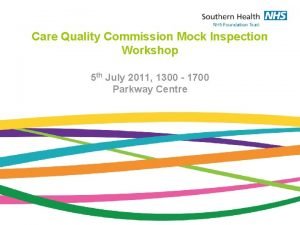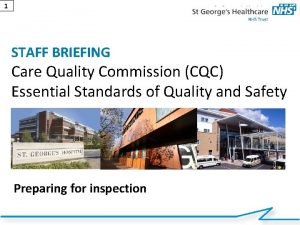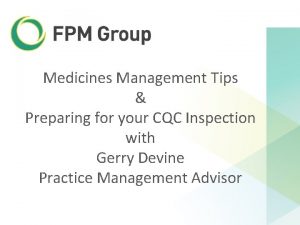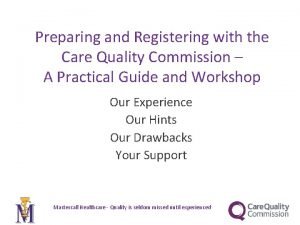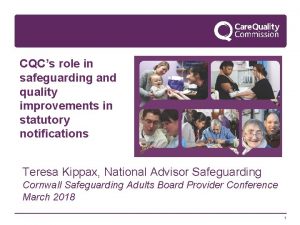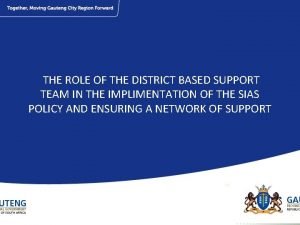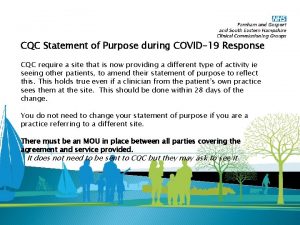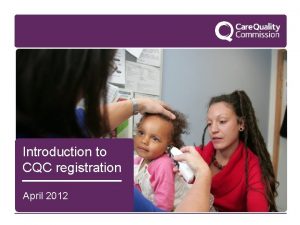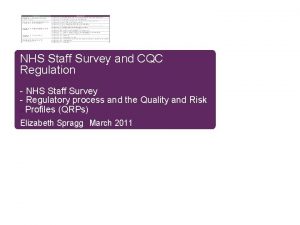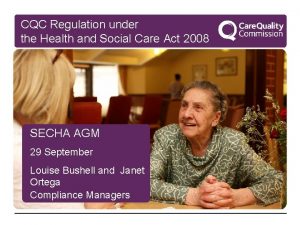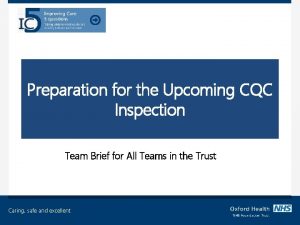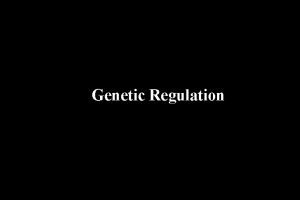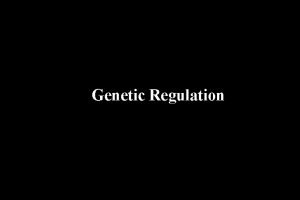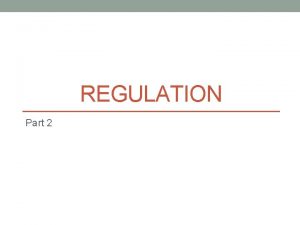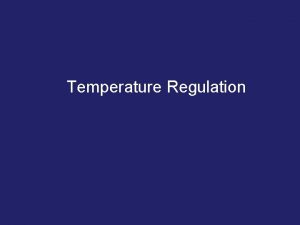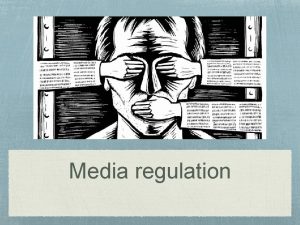David James CQC Policy Team Technology and regulation
















- Slides: 16

David James – CQC Policy Team

Technology and regulation Dave James Head of Adult Social Care Policy, Care Quality Commission 2

Purpose of this session • To describe CQC’s approach to assessing outcomes and how this applies to technology in care • To prompt a discussion on our approach, future challenges and how we can all work together to ensure technology can be used to underpin high quality care 3

A quick show of hands Do you think CQC is a barrier to technological innovation in adult social care? 4

Our purpose and role • We make sure health and social care services provide people with safe, effective, compassionate, high-quality care and we encourage care services to improve • • • Register Monitor and inspect Use legal powers Speak independently Encourage improvement • People have a right to expect safe, good care from their health and social care services 5

Ambition for social care: The Mum Test (or Anyone You Love test) Is it effective? Is it responsive to people’s needs? Is it safe? Is it well-led? Is it caring? Is it good enough for my Mum? 6

Ratings based on outcomes Outstanding The service is performing exceptionally well. Good The service is performing well and above minimum legal requirements. Requires improvement The service isn't performing and may be in breach of legal requirements. Inadequate The service is performing badly, is in breach and we've taken action. 7

The Characteristics of Good and Outstanding care SAFE ü People protected from avoidable harm and abuse ü Supported to keep themselves and belongings safe and secure EFFECTIVE ü People’s outcomes and feedback are consistently good ü Outcomes are consistently better than other similar services CARING ü people supported, treated with dignity and respect and involved as partners in their care RESPONSIVE ü Needs met through way services organised & delivered ü Meet needs of individual and ensure flexibility, choice and continuity of care WELL-LED ü the service is consistently well-managed and led ü the leadership, governance and culture drive high-quality, person-centre care 8

Technology in care • Technology is changing how care is provided & the benefits can be significant – technology can; v v v give people more control over their health, safety and wellbeing Increase independence, decrease isolation link to services which are important to people enhance the effectiveness of care or treatment help people communicate with families, professionals and staff help staff to prioritise and focus their attention on people who need it most v capture and compare data, and share good practice with peers. • But technology and other innovations should never come at the expense of high-quality, person-centred care - the interests of the person using the service must be at the heart of any decision to use technology

Technology in care Some questions that will help you prepare if you’re thinking about using technology to deliver care – CQC will want to know the answers too! Involving people Ø Who will the technology affect and how? Ø How will you involve them in your plans? Ø What do they need to know to make an informed choice? Do they fully understand the implications of the new technology? Ø How have you involved your staff? What information and training do they need so they can be confident and competent? Clarity of ambition Ø What outcome do you want to achieve? How will you measure it? Safety and legal considerations Ø What are the practical and legal issues you need to think about before you introduce new technology? Ø What are the risks and how will you manage them, particularly during transition & early implementation? How will you keep people safe?

The (draft!) areas of focus… Person Centred • respects the needs and preferences of the person using the service • promotes good outcomes for people including independence whilst supporting them to stay safe Drives Improvement • positive impact on outcomes • clear how tech improves service & evaluation Confident Staff • staff understand confident with tech including how to raise concerns or changes in need Privacy and Dignity Open and • impact on privacy and Transparent dignity fully considered e. g. minimising intrusion • people who use, visit or work at the service are aware of purpose and impacts Appropriate and Proportionate • best way to meet need or intended purpose System Security Managing Risk and Data Protection • promotes safety – in Capacity and Consent • operated and maintained legally, in a way that keeps people’s information safe • contingency plans in place • people can express views, actively involved in decisions • supported to give informed consent & free to withdraw at any time. • consent sought in line with MCA line with safeguarding processes • risks assessed and plans to manage them in place

Mapping to the Characteristics of Ratings SAFE ü People protected from avoidable harm and abuse ü Supported to keep themselves and belongings safe and secure ü Confident Staff ü System Security and Data Protection ü Managing risk EFFECTIVE ü People’s outcomes and feedback are consistently good ü Outcomes are consistently better than other similar services ü Capacity and Consent ü Open and Transparent CARING ü people supported, treated with dignity and respect and involved as partners in their care ü Privacy and dignity RESPONSIVE ü Needs met through way services organised & delivered ü Meet needs of individual and ensure flexibility, choice and continuity of care ü Person centred ü Appropriate and Proportionate WELL-LED ü the service is consistently well-managed and led ü the leadership, governance and culture drive high-quality, person-centre care ü Driving improvement 12

An example of what this looks like in practice Confident Staff understand how to use the technology or apply the innovation and are confident to do so. They have completed any relevant training and understand their responsibilities, including how to raise concerns or changes in need. S 3: How does the service make sure that there are sufficient numbers of suitable staff to support people to stay safe and meet their needs? S 3. 1: What arrangements are there, including within the rotas, for making sure that staff have the right mix of skills, competencies, qualifications, experience and knowledge, to meet people’s individual needs? Regulation 12: safe care and treatment Regulation 18: Staffing Regulation 19: Fit and proper persons employed S 3. 2: How is safety promoted in recruitment practices, arrangements to support staff, training arrangements, disciplinary procedures, and ongoing checks? Regulation 12: safe care and treatment Regulation 18: Staffing Regulation 19: Fit and proper persons employed S 3. 3: Do staff receive effective training in safety systems, processes and practices? Regulation 12: safe care and treatment Regulation 18: Staffing Regulation 19: Fit and proper persons employed 13

Closing thoughts • Risk that sole focus on outcomes might not always be enough – e. g. AI making clinical decisions • How we do assess the safety of the algorithms? • What is our role and what is the role of other agencies? • How do we stay on top of current developments? • Need to continue to engage and learn, asking; o “Is it new? ” o “How does it affect quality? ” o “Does it affect CQC’s methodology or scope of regulation? ” • Answers will determine whether CQC will apply ‘Regulatory Sandboxing’ where implementation of technology can be tested against the regulations in a controlled way, to ensure that regulation achieves the best outcome for people using services. • See https: //www. cqc. org. uk/guidance-providers/all-services/technology-care for more info 14

A quick show of hands Do you think CQC is a barrier to technological innovation in adult social care? 15

Any questions or comments? 16
 James russell odom
James russell odom James russell odom
James russell odom Cqc chloe
Cqc chloe Cqc mock inspection template
Cqc mock inspection template Cqc 5 standards
Cqc 5 standards Cqc staff
Cqc staff What is cqc
What is cqc Combat breathing
Combat breathing Cqc medicines management
Cqc medicines management Ann ford cqc
Ann ford cqc Cqc mock inspection toolkit
Cqc mock inspection toolkit Cqc safeguarding notification
Cqc safeguarding notification What is the role of the school based support team
What is the role of the school based support team Bureaucratic bypass syndrome
Bureaucratic bypass syndrome Team spirit becomes team infatuation
Team spirit becomes team infatuation The white team cheers for the blue team, just like
The white team cheers for the blue team, just like David james grandad
David james grandad



